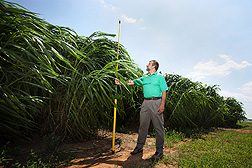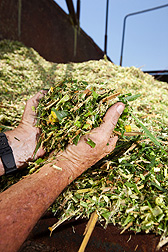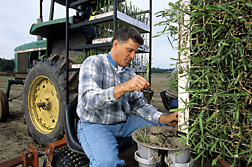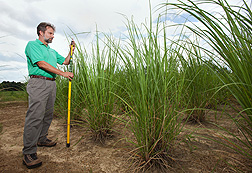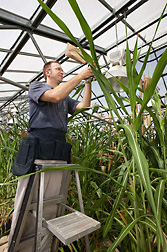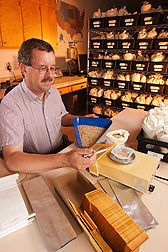Finding the Right Biofuels for the Southeast:
A Range of Alternatives
Thanks to sunny skies and long growing seasons, farms and forests in the southeastern United States will play a major role in efforts to produce biomass for biofuels that reduce our nation’s dependence on fossil fuels. And Agricultural Research Service scientists are focused on finding ways to tap into the region’s potential.
Government mandates call for producing up to 36 billion gallons of biofuel to help meet the nation’s transportation needs by 2022. While 15 billion gallons of that is expected to come from grain ethanol, the remaining 21 billion gallons will be derived from other feedstocks, such as sugarcane; perennial grasses, like switchgrass; and oilseed crops, such as rapeseed, pennycress, camelina, and soybean.
To achieve that goal, the U.S. Department of Agriculture has forged a number of strategic partnerships through its five USDA Regional Biomass Research Centers to coordinate research and tap into its nationwide resources and expertise.The centers are networks of scientists and facilities from two USDA agencies—ARS and the Forest Service Research and Development—in five regions across the United States: Central-East, Southeastern, Northern-East, Western, and Northwestern. (See related stories in this issue.) Of the five regions, the Southeast has the greatest natural capacity in the continental United States, with sufficient sunshine, soils, water, and other natural resources to produce more than 10 billion gallons of advanced biofuels each year, nearly a third of the 36 billion-gallon production target.
|
|
The goal for researchers is to develop high-yield bioenergy crops and production methods that minimize use of water and fertilizers and are compatible with current land uses. The systems have to be cost-effective for both growers and biofuel producers. Researchers also want to enhance environmental quality by increasing carbon sequestration and reduce the amount of nitrogen runoff to waterways.
“We need to understand all of the implications of helping this country meet its future energy needs by producing plants that will be viable sources of fuel. That means examining a number of issues, such as whether these crops can be produced on less productive lands in ways that preserve environmental quality,” says William Anderson, an ARS geneticist in Tifton, Georgia, and co-coordinator of the Southeastern Regional Biomass Center.
ARS researchers working in Georgia, Louisiana, Nebraska, Hawaii, and elsewhere, with expertise in a wide range of scientific fields, are working toward developing a range of biomass crops for biofuels. They are finding that each crop offers a different set of challenges—and possible rewards. Work by Anderson and others, for instance, shows that napiergrass (Pennisetum purpureum) and varieties of sugarcane known as “energy cane” (Saccharum sp.) may work best in southern portions of Georgia and the rest of the region’s southern tier. By comparison, switchgrass (Panicum virgatum), a biomass crop being developed in the Midwest, is more cold tolerant than subtropical grasses and works better than energy cane in more northern areas of the Southeast.
Much of the USDA research effort in the South is focused on energy cane, napiergrass, and sweet sorghum (Sorghum bicolor). With its expertise, extensive network of university and industry partners, and vast collections of plant material available for research, ARS is uniquely equipped to play a pivotal role in developing all three of these grasses into viable feedstocks for biofuels. ARS researchers are also working closely with companies that will produce biofuels so that they understand the companies’ priorities and are using that insight in their efforts. It’s an approach that is helping to accelerate progress toward lowering the potential costs of producing biofuels and making the biofuels price competitive with that of petroleum fuels.
|
|
The Sugarcane Connection
At the ARS Sugarcane Research Unit in Houma, Louisiana, and its field location in Canal Point, Florida, scientists are engaged in a program to supply growers and energy companies in the Gulf Coast and other southern states with new varieties of energy cane. Energy canes are derived by crossing cultivated sugarcane with related wild grassy species that offer desirable traits for biofuel production. A key attribute from wild grasses is their high amount of stalk fiber, which has cellulose and other complex carbohydrates that can be converted into ethanol, complementing the ethanol that would be produced from the sugar.
Another desirable trait from wild grass species is cold tolerance, important to both energy cane and traditional forms of sugarcane. Incorporating this trait would not only extend the growing and milling season, but also enable production in states where sugarcane is not traditionally grown, such as Arkansas, Mississippi, Georgia, and the Carolinas. (Commercial sugar production on the U.S. mainland is currently limited to Louisiana, southern Florida, and Texas.)
|
|
“We don’t anticipate any energy cane being grown in the traditional sugarcane growing areas of Florida, Louisiana, Texas, or Hawaii,” says Ed Richard, who, prior to retiring in December 2011, led a 12-member energy cane research team at Houma. “We envision it being grown in the more northern zones of these states and in the other southern states, in rotations with pasture and other croplands that are not productive. In Hawaii, it may be grown on hilly land that is hard to irrigate,” he says.
In Gulf Coast states like Louisiana and Florida, sugarcane is better suited to the region’s soil types and subtropical climate. “A long growing season, abundance of land, and the availability of water make the Southeast ideal for the production of tall-growing herbaceous perennials,” like sugarcane, sweet sorghum, and other related species, says Richard.
To date, the Houma group has released four energy cane varieties as part of a longstanding cooperative agreement with the Louisiana State University AgCenter and the American Sugar Cane League.
|
|
Napiergrass: Right for Some, Maybe Not For All
Napiergrass, also called “elephant grass,” is a native of Africa and is used as cattle forage in much of the Tropics. Napiergrass offers advantages for the Southeast: It is drought tolerant and grows well on marginal lands and in riparian areas. It can also improve water quality in riparian areas by filtering out nutrients in runoff from row crop fields.
Both energy cane and napiergrass are subtropical grasses and are prime candidates for biomass production because they don’t flower in most areas of the Southeast and continue to grow until the first frost.
In Tifton, Georgia, Anderson and colleagues compared napiergrass to energy cane, switchgrass, and giant reed (Arundo donax). They grew the crops for 4 years and compared biomass yields and soil nutrient requirements. Joseph Knoll, a postdoctoral researcher in Anderson’s laboratory in the ARS Crop Genetics and Breeding Research Unit in Tifton, led the research effort. The team also included Timothy Strickland and Robert Hubbard, ARS scientists with the Southeast Regional Watershed Research Unit in Tifton, and Ravindra Malik of Albany State University, Albany, Georgia. Results were published online in BioEnergy Research in 2012.
They found that energy cane and napiergrass are viable biofuel alternatives for growers in southern portions of Georgia and the rest of the region’s southern tier, Anderson says. “Energy cane and napiergrass are not as cold tolerant as switchgrass, but they do offer advantages in areas where they can be produced, such as continued vegetative growth until killing frost,” Anderson says.
Anderson and his colleagues are evaluating napiergrass with an eye toward improving yields, useable fiber content, and disease resistance. They are also testing different soil amendments, such as chicken litter, variable rates of inorganic fertilizer, and winter cover crops, and comparing those with no use of inputs.
“In one test, we’re looking at six different rates of fertilizer use as well as different irrigation levels. We’ve also looked at the times of planting and harvest, comparing yields in areas where poultry litter was used and where synthetic fertilizer was used,” Anderson says. Preliminary findings show that yields are sufficient without irrigation and that there is little difference in yield when poultry litter is used instead of inorganic fertilizer.
Sorghum’s Potential: How Sweet It Is
Sweet sorghum is a sturdy grass grown in the United States for livestock forage and for sugar for making syrup and molasses. But several attributes make it uniquely suited as a bioenergy crop in the Southeast. It is drought tolerant; adapts to diverse growing conditions; has low nitrogen fertilizer requirements; produces abundant biomass; can be rotated with cotton and peanuts; and is compatible with equipment used to harvest, transport, and mill sugarcane.It also contains soluble sugar that can be fermented directly into biofuel. The fiber (or bagasse) that remains after the sugar juice is extracted can be burned to generate electrical power—a strategy that South American sugarcane-producing countries are expanding.
“Sweet sorghum has the potential to augment biofuel and electricity production from cultivated sugarcane and lengthen the season for bioenergy production,” says plant geneticist Jeff Pedersen, a former ARS scientist who was based in Lincoln, Nebraska, and collaborated on sweet sorghum studies for the Southeastern region before he retired in 2011.
In Tifton, Anderson and other researchers are trying to identify desirable sweet sorghum genes and understand their functions so they can improve on commercial varieties. The researchers selected 117 sweet sorghum genotypes from the ARS sorghum germplasm collection in Griffin, Georgia, where sorghum seeds from around the world are kept. (See sidebar below.)
They tested the genotypes for 2 years, evaluating their ability to mature quickly and resist fall armyworm and anthracnose, a common fungal disease.
The results are providing much-needed guidance to a growing biofuel industry, showing that sweet sorghum has tremendous potential as a biofuel crop for Southeast growers. The work also boosts efforts among breeders by identifying sorghum varieties that will make good candidates for developing future high-seed-yielding hybrid varieties.
For all of sweet sorghum’s bioenergy promise, there’s still much work to be done, says Pedersen. In his estimation, sweet sorghum’s long-term future as a bioenergy crop hinges on the ability of the seed industry to rapidly generate and deliver new elite hybrids—using dwarf seed-parent lines—that produce high yields of seed. Besides enabling laboratory and field research, having sufficient seed stocks “is going to be essential to getting the bioenergy industry going,” says Pedersen.
The sweet sorghum improvement research work is one of several examples of work being done by researchers in Tifton to produce market-ready biofuel feedstocks. Environmental concerns are also a high priority being addressed by the Southeast Watershed Research Laboratory, in Tifton. “The lab is looking at potential effects on water quality, runoff, water-use efficiency, and carbon-nitrogen pools in soils and plant tissue as biomass feedstock species are incorporated into Southeast agricultural systems,” Anderson says.—By Dennis O'Brienand Jan Suszkiw, Agricultural Research Service Information Staff.
To reach scientists mentioned in this article, contact Dennis O’Brien, USDA-ARS Information Staff, 5601 Sunnyside Ave., Beltsville MD 20705-5129; (301) 504-1624.
The ARS locations included in this story are part of USDA’s Regional Biomass Research Centers (RBRC) network. The RBRC is made up of five national centers whose mission is to help accelerate the establishment and production of sustainable commercial biomass from farms and forests without disrupting the production and marketing of food, feed, and fiber.
|
|
Sweet Sorghum Research: Building on the Past for a Better Future
Fuel-friendly varieties of sweet sorghum will need durable resistance to insect pests like fall armyworms and diseases such as maize dwarf mosaic. Breeders will also have to incorporate traits that prevent stalks from lodging, or toppling over, as they grow tall. Lodging is a problem because the crop will require mechanical harvesters. Fortunately, the Agricultural Research Service has a long history of sweet sorghum research and germplasm development dating back several decades. Its sizeable germplasm collection contains 2,163 accessions of sweet sorghum from around the world, which are maintained by Gary Pederson and colleagues at ARS’s Plant Genetic Resources Conservation Unit in Griffin, Georgia. Among other projects, scientists there are assessing the sugar profiles of select sweet sorghum accessions and genetically characterizing them using DNA markers so that plant breeders can develop varieties suited for biofuel production.
Other ARS scientists are also conducting bioenergy research on sweet sorghum:
Molecular biologist Scott Sattler at Lincoln, Nebraska, is identifying genes, enzymes, and biochemical pathways involved in the crop’s production of sucrose and other sugars. Ultimately, this will lead to new ways to ratchet up the activity of these genes or reengineer the pathways for even higher sugar yields than can be achieved with conventional plant-breeding methods.
In New Orleans, scientists Gillian Eggleston, Sarah Lingle (retired), and Maureen Wright at ARS’s Southern Regional Research Center are focused on developing industrial process technologies to manufacture sweet sorghum syrup for year-round storage and transport and to maximize biofuel yields and other value-added biobased products, such as succinic acid. They are also determining whether starch, aconitic acid, and other impurities slow down fermentation and need to be removed to reduce the costs of production.
At Manhattan, Kansas, Scott Bean and colleagues at ARS’s Grain Quality and Structure Research Unit are investigating the fermentation performance of “waxy” grain sorghum for ethanol production.—By Jan Suszkiw, Agricultural Research Service Information Staff.
"Finding the Right Biofuels for the Southeast: A Range of Alternatives" was published in the September 2012 issue of Agricultural Research magazine.







